Research Paradigm
VerifiedAdded on 2023/04/20
|7
|1316
|132
AI Summary
A research paradigm is a conventional view of the values and beliefs of a research that guides how to provide a solution to a research problem. Learn about the major characteristics and types of research paradigms.
Contribute Materials
Your contribution can guide someone’s learning journey. Share your
documents today.

Running Head: PARADIGM
1
RESEARCH PARADIGM
Name of Student:
Name of Institution:
Author Note:
1
RESEARCH PARADIGM
Name of Student:
Name of Institution:
Author Note:
Secure Best Marks with AI Grader
Need help grading? Try our AI Grader for instant feedback on your assignments.
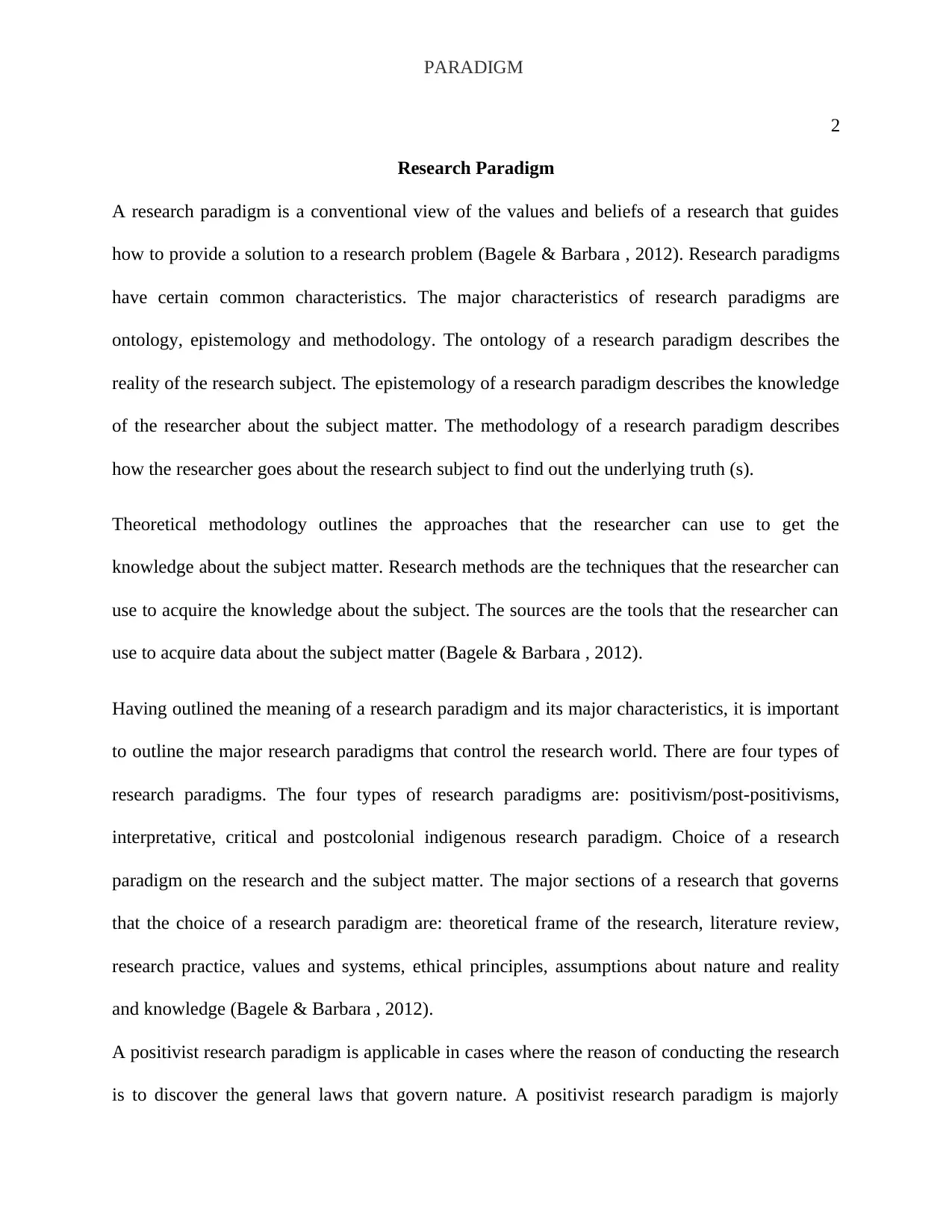
PARADIGM
2
Research Paradigm
A research paradigm is a conventional view of the values and beliefs of a research that guides
how to provide a solution to a research problem (Bagele & Barbara , 2012). Research paradigms
have certain common characteristics. The major characteristics of research paradigms are
ontology, epistemology and methodology. The ontology of a research paradigm describes the
reality of the research subject. The epistemology of a research paradigm describes the knowledge
of the researcher about the subject matter. The methodology of a research paradigm describes
how the researcher goes about the research subject to find out the underlying truth (s).
Theoretical methodology outlines the approaches that the researcher can use to get the
knowledge about the subject matter. Research methods are the techniques that the researcher can
use to acquire the knowledge about the subject. The sources are the tools that the researcher can
use to acquire data about the subject matter (Bagele & Barbara , 2012).
Having outlined the meaning of a research paradigm and its major characteristics, it is important
to outline the major research paradigms that control the research world. There are four types of
research paradigms. The four types of research paradigms are: positivism/post-positivisms,
interpretative, critical and postcolonial indigenous research paradigm. Choice of a research
paradigm on the research and the subject matter. The major sections of a research that governs
that the choice of a research paradigm are: theoretical frame of the research, literature review,
research practice, values and systems, ethical principles, assumptions about nature and reality
and knowledge (Bagele & Barbara , 2012).
A positivist research paradigm is applicable in cases where the reason of conducting the research
is to discover the general laws that govern nature. A positivist research paradigm is majorly
2
Research Paradigm
A research paradigm is a conventional view of the values and beliefs of a research that guides
how to provide a solution to a research problem (Bagele & Barbara , 2012). Research paradigms
have certain common characteristics. The major characteristics of research paradigms are
ontology, epistemology and methodology. The ontology of a research paradigm describes the
reality of the research subject. The epistemology of a research paradigm describes the knowledge
of the researcher about the subject matter. The methodology of a research paradigm describes
how the researcher goes about the research subject to find out the underlying truth (s).
Theoretical methodology outlines the approaches that the researcher can use to get the
knowledge about the subject matter. Research methods are the techniques that the researcher can
use to acquire the knowledge about the subject. The sources are the tools that the researcher can
use to acquire data about the subject matter (Bagele & Barbara , 2012).
Having outlined the meaning of a research paradigm and its major characteristics, it is important
to outline the major research paradigms that control the research world. There are four types of
research paradigms. The four types of research paradigms are: positivism/post-positivisms,
interpretative, critical and postcolonial indigenous research paradigm. Choice of a research
paradigm on the research and the subject matter. The major sections of a research that governs
that the choice of a research paradigm are: theoretical frame of the research, literature review,
research practice, values and systems, ethical principles, assumptions about nature and reality
and knowledge (Bagele & Barbara , 2012).
A positivist research paradigm is applicable in cases where the reason of conducting the research
is to discover the general laws that govern nature. A positivist research paradigm is majorly
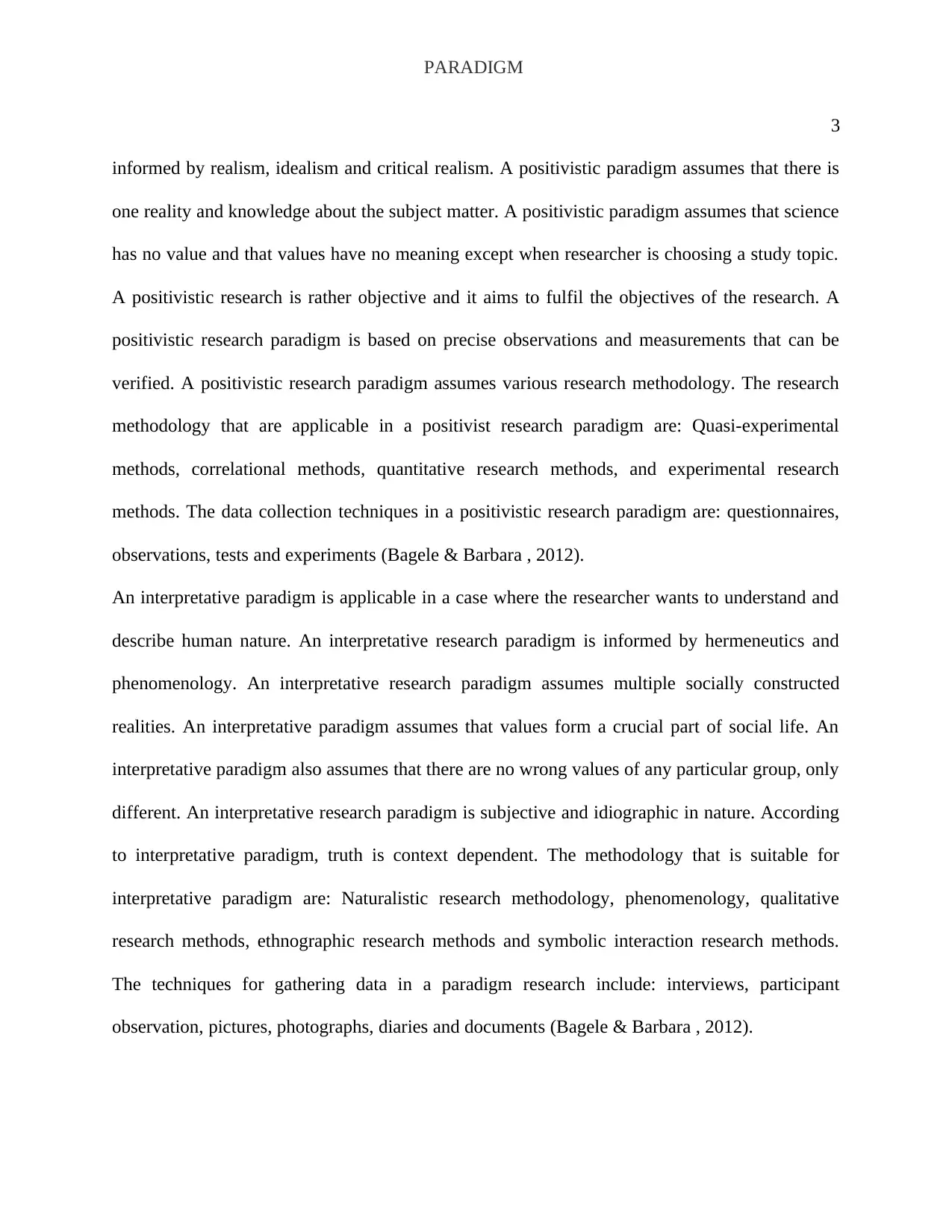
PARADIGM
3
informed by realism, idealism and critical realism. A positivistic paradigm assumes that there is
one reality and knowledge about the subject matter. A positivistic paradigm assumes that science
has no value and that values have no meaning except when researcher is choosing a study topic.
A positivistic research is rather objective and it aims to fulfil the objectives of the research. A
positivistic research paradigm is based on precise observations and measurements that can be
verified. A positivistic research paradigm assumes various research methodology. The research
methodology that are applicable in a positivist research paradigm are: Quasi-experimental
methods, correlational methods, quantitative research methods, and experimental research
methods. The data collection techniques in a positivistic research paradigm are: questionnaires,
observations, tests and experiments (Bagele & Barbara , 2012).
An interpretative paradigm is applicable in a case where the researcher wants to understand and
describe human nature. An interpretative research paradigm is informed by hermeneutics and
phenomenology. An interpretative research paradigm assumes multiple socially constructed
realities. An interpretative paradigm assumes that values form a crucial part of social life. An
interpretative paradigm also assumes that there are no wrong values of any particular group, only
different. An interpretative research paradigm is subjective and idiographic in nature. According
to interpretative paradigm, truth is context dependent. The methodology that is suitable for
interpretative paradigm are: Naturalistic research methodology, phenomenology, qualitative
research methods, ethnographic research methods and symbolic interaction research methods.
The techniques for gathering data in a paradigm research include: interviews, participant
observation, pictures, photographs, diaries and documents (Bagele & Barbara , 2012).
3
informed by realism, idealism and critical realism. A positivistic paradigm assumes that there is
one reality and knowledge about the subject matter. A positivistic paradigm assumes that science
has no value and that values have no meaning except when researcher is choosing a study topic.
A positivistic research is rather objective and it aims to fulfil the objectives of the research. A
positivistic research paradigm is based on precise observations and measurements that can be
verified. A positivistic research paradigm assumes various research methodology. The research
methodology that are applicable in a positivist research paradigm are: Quasi-experimental
methods, correlational methods, quantitative research methods, and experimental research
methods. The data collection techniques in a positivistic research paradigm are: questionnaires,
observations, tests and experiments (Bagele & Barbara , 2012).
An interpretative paradigm is applicable in a case where the researcher wants to understand and
describe human nature. An interpretative research paradigm is informed by hermeneutics and
phenomenology. An interpretative research paradigm assumes multiple socially constructed
realities. An interpretative paradigm assumes that values form a crucial part of social life. An
interpretative paradigm also assumes that there are no wrong values of any particular group, only
different. An interpretative research paradigm is subjective and idiographic in nature. According
to interpretative paradigm, truth is context dependent. The methodology that is suitable for
interpretative paradigm are: Naturalistic research methodology, phenomenology, qualitative
research methods, ethnographic research methods and symbolic interaction research methods.
The techniques for gathering data in a paradigm research include: interviews, participant
observation, pictures, photographs, diaries and documents (Bagele & Barbara , 2012).
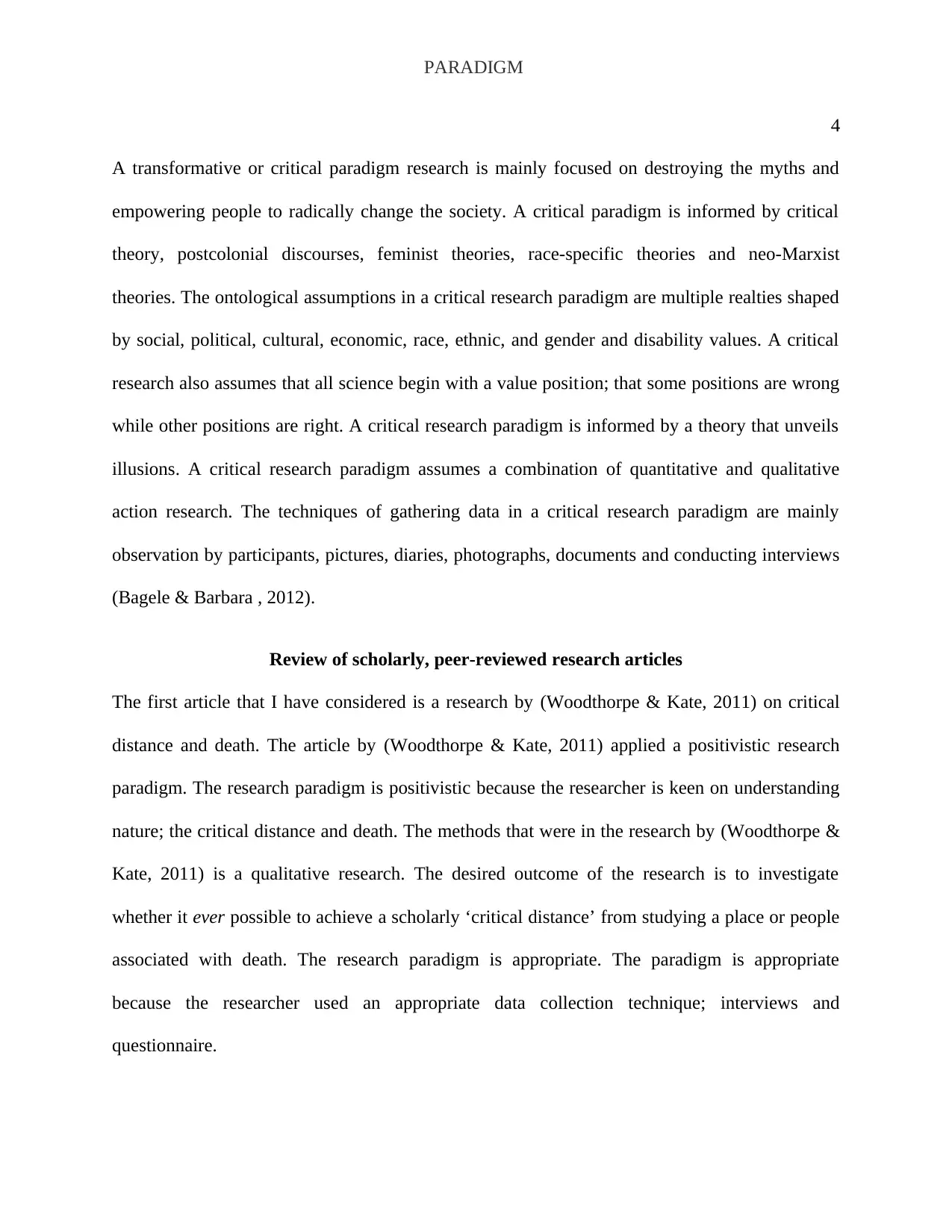
PARADIGM
4
A transformative or critical paradigm research is mainly focused on destroying the myths and
empowering people to radically change the society. A critical paradigm is informed by critical
theory, postcolonial discourses, feminist theories, race-specific theories and neo-Marxist
theories. The ontological assumptions in a critical research paradigm are multiple realties shaped
by social, political, cultural, economic, race, ethnic, and gender and disability values. A critical
research also assumes that all science begin with a value position; that some positions are wrong
while other positions are right. A critical research paradigm is informed by a theory that unveils
illusions. A critical research paradigm assumes a combination of quantitative and qualitative
action research. The techniques of gathering data in a critical research paradigm are mainly
observation by participants, pictures, diaries, photographs, documents and conducting interviews
(Bagele & Barbara , 2012).
Review of scholarly, peer-reviewed research articles
The first article that I have considered is a research by (Woodthorpe & Kate, 2011) on critical
distance and death. The article by (Woodthorpe & Kate, 2011) applied a positivistic research
paradigm. The research paradigm is positivistic because the researcher is keen on understanding
nature; the critical distance and death. The methods that were in the research by (Woodthorpe &
Kate, 2011) is a qualitative research. The desired outcome of the research is to investigate
whether it ever possible to achieve a scholarly ‘critical distance’ from studying a place or people
associated with death. The research paradigm is appropriate. The paradigm is appropriate
because the researcher used an appropriate data collection technique; interviews and
questionnaire.
4
A transformative or critical paradigm research is mainly focused on destroying the myths and
empowering people to radically change the society. A critical paradigm is informed by critical
theory, postcolonial discourses, feminist theories, race-specific theories and neo-Marxist
theories. The ontological assumptions in a critical research paradigm are multiple realties shaped
by social, political, cultural, economic, race, ethnic, and gender and disability values. A critical
research also assumes that all science begin with a value position; that some positions are wrong
while other positions are right. A critical research paradigm is informed by a theory that unveils
illusions. A critical research paradigm assumes a combination of quantitative and qualitative
action research. The techniques of gathering data in a critical research paradigm are mainly
observation by participants, pictures, diaries, photographs, documents and conducting interviews
(Bagele & Barbara , 2012).
Review of scholarly, peer-reviewed research articles
The first article that I have considered is a research by (Woodthorpe & Kate, 2011) on critical
distance and death. The article by (Woodthorpe & Kate, 2011) applied a positivistic research
paradigm. The research paradigm is positivistic because the researcher is keen on understanding
nature; the critical distance and death. The methods that were in the research by (Woodthorpe &
Kate, 2011) is a qualitative research. The desired outcome of the research is to investigate
whether it ever possible to achieve a scholarly ‘critical distance’ from studying a place or people
associated with death. The research paradigm is appropriate. The paradigm is appropriate
because the researcher used an appropriate data collection technique; interviews and
questionnaire.
Secure Best Marks with AI Grader
Need help grading? Try our AI Grader for instant feedback on your assignments.
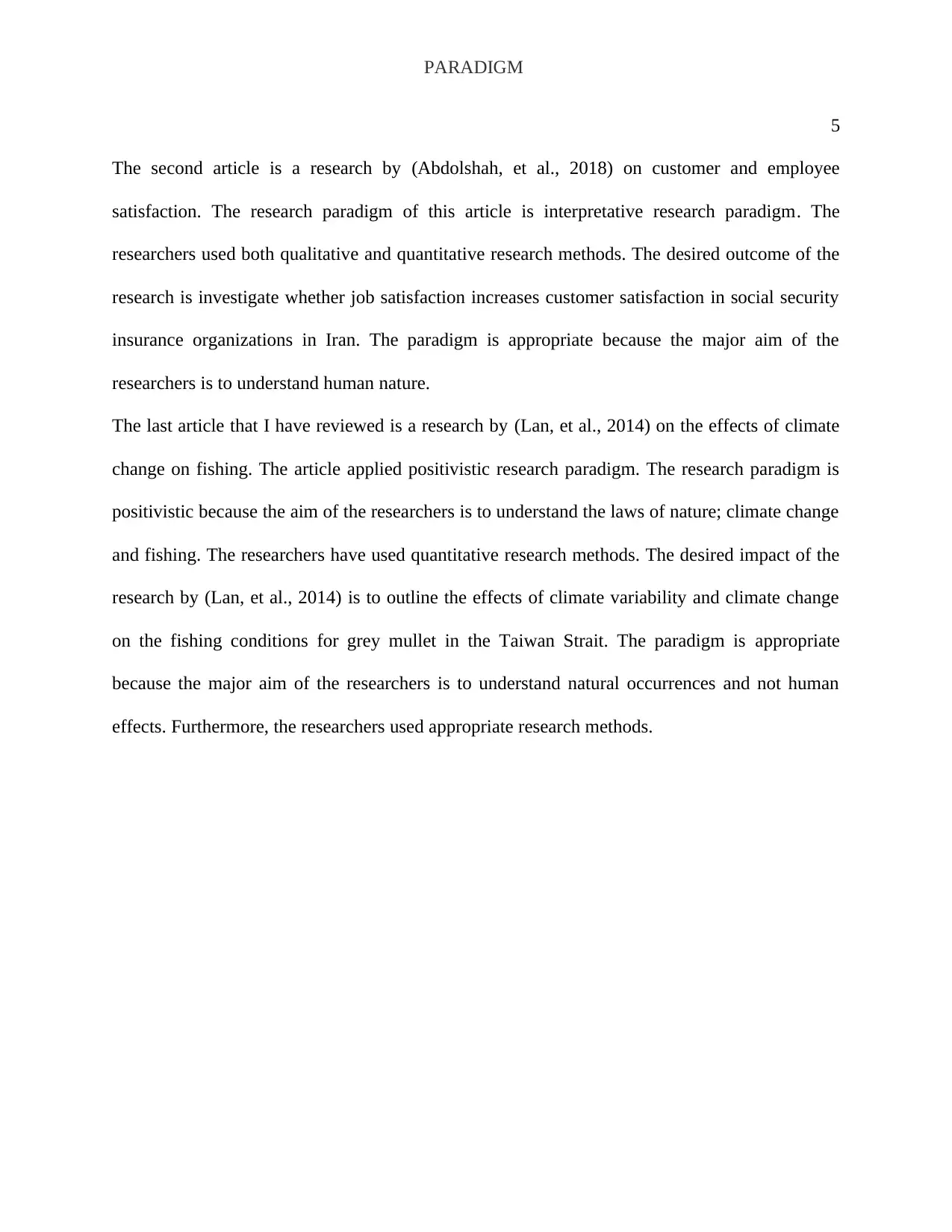
PARADIGM
5
The second article is a research by (Abdolshah, et al., 2018) on customer and employee
satisfaction. The research paradigm of this article is interpretative research paradigm. The
researchers used both qualitative and quantitative research methods. The desired outcome of the
research is investigate whether job satisfaction increases customer satisfaction in social security
insurance organizations in Iran. The paradigm is appropriate because the major aim of the
researchers is to understand human nature.
The last article that I have reviewed is a research by (Lan, et al., 2014) on the effects of climate
change on fishing. The article applied positivistic research paradigm. The research paradigm is
positivistic because the aim of the researchers is to understand the laws of nature; climate change
and fishing. The researchers have used quantitative research methods. The desired impact of the
research by (Lan, et al., 2014) is to outline the effects of climate variability and climate change
on the fishing conditions for grey mullet in the Taiwan Strait. The paradigm is appropriate
because the major aim of the researchers is to understand natural occurrences and not human
effects. Furthermore, the researchers used appropriate research methods.
5
The second article is a research by (Abdolshah, et al., 2018) on customer and employee
satisfaction. The research paradigm of this article is interpretative research paradigm. The
researchers used both qualitative and quantitative research methods. The desired outcome of the
research is investigate whether job satisfaction increases customer satisfaction in social security
insurance organizations in Iran. The paradigm is appropriate because the major aim of the
researchers is to understand human nature.
The last article that I have reviewed is a research by (Lan, et al., 2014) on the effects of climate
change on fishing. The article applied positivistic research paradigm. The research paradigm is
positivistic because the aim of the researchers is to understand the laws of nature; climate change
and fishing. The researchers have used quantitative research methods. The desired impact of the
research by (Lan, et al., 2014) is to outline the effects of climate variability and climate change
on the fishing conditions for grey mullet in the Taiwan Strait. The paradigm is appropriate
because the major aim of the researchers is to understand natural occurrences and not human
effects. Furthermore, the researchers used appropriate research methods.
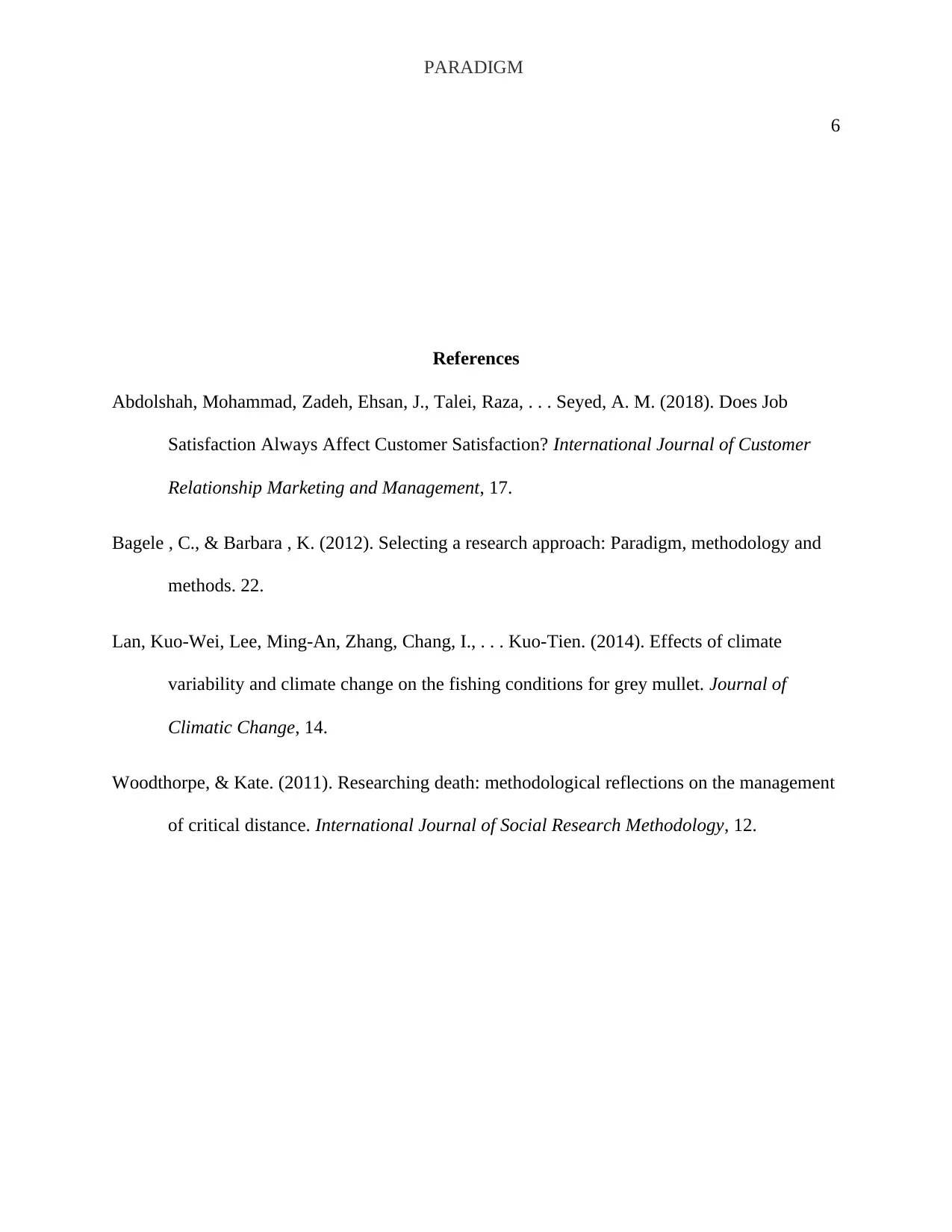
PARADIGM
6
References
Abdolshah, Mohammad, Zadeh, Ehsan, J., Talei, Raza, . . . Seyed, A. M. (2018). Does Job
Satisfaction Always Affect Customer Satisfaction? International Journal of Customer
Relationship Marketing and Management, 17.
Bagele , C., & Barbara , K. (2012). Selecting a research approach: Paradigm, methodology and
methods. 22.
Lan, Kuo-Wei, Lee, Ming-An, Zhang, Chang, I., . . . Kuo-Tien. (2014). Effects of climate
variability and climate change on the fishing conditions for grey mullet. Journal of
Climatic Change, 14.
Woodthorpe, & Kate. (2011). Researching death: methodological reflections on the management
of critical distance. International Journal of Social Research Methodology, 12.
6
References
Abdolshah, Mohammad, Zadeh, Ehsan, J., Talei, Raza, . . . Seyed, A. M. (2018). Does Job
Satisfaction Always Affect Customer Satisfaction? International Journal of Customer
Relationship Marketing and Management, 17.
Bagele , C., & Barbara , K. (2012). Selecting a research approach: Paradigm, methodology and
methods. 22.
Lan, Kuo-Wei, Lee, Ming-An, Zhang, Chang, I., . . . Kuo-Tien. (2014). Effects of climate
variability and climate change on the fishing conditions for grey mullet. Journal of
Climatic Change, 14.
Woodthorpe, & Kate. (2011). Researching death: methodological reflections on the management
of critical distance. International Journal of Social Research Methodology, 12.

PARADIGM
7
7
1 out of 7
Related Documents
Your All-in-One AI-Powered Toolkit for Academic Success.
+13062052269
info@desklib.com
Available 24*7 on WhatsApp / Email
![[object Object]](/_next/static/media/star-bottom.7253800d.svg)
Unlock your academic potential
© 2024 | Zucol Services PVT LTD | All rights reserved.





